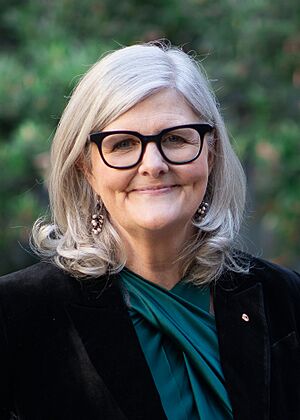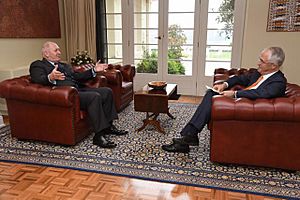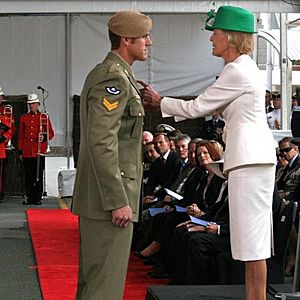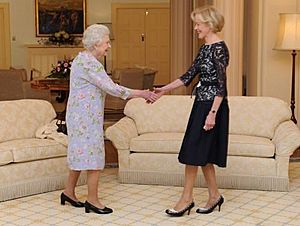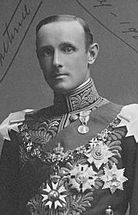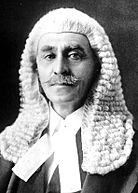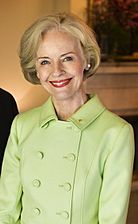Governor-General of Australia facts for kids
Quick facts for kids Governor-General of the Commonwealth of Australia |
|
|---|---|

|
|

Badge
|
|
| Viceregal | |
| Style | Her Excellency the Honourable |
| Residence | Government House (Canberra) Admiralty House (Sydney) |
| Appointer | Monarch of Australia
on the advice of the prime minister
|
| Term length | At His Majesty's pleasure
(typically 5 years)
|
| Constituting instrument | Australian Constitution |
| Formation | 29 October 1900 |
| First holder | John Hope, 7th Earl of Hopetoun |
| Salary | $709,017 |
The governor-general of Australia is the main representative of the King or Queen of Australia, currently Charles III. This important role involves many duties in Australia's government and community. The governor-general usually follows the advice of the prime minister and the government.
The governor-general has several key jobs. They approve new laws, call for elections, and officially appoint government leaders like the prime minister, judges, and ambassadors. They also act as the commander-in-chief of the Australian Defence Force and give out Australian awards. Most of the time, the governor-general acts according to Australia's political system, which means they stay politically neutral. They follow the decisions of the Parliament or the advice of ministers.
However, in special situations, the governor-general can use "reserve powers." These are powers they can use without or against the government's advice. A famous example was during the 1975 Australian constitutional crisis. These powers are often debated.
In their community role, the governor-general represents Australia. They attend important events, support community groups, and host gatherings at their official homes in Canberra and Sydney. They also travel overseas to represent Australia. The governor-general has a team of staff to help them.
The prime minister chooses the governor-general, and the King or Queen formally appoints them. They usually serve for five years. Since 1965, all governors-general have been Australian citizens. The current governor-general is Sam Mostyn, who is the second woman to hold this position.
Contents
Becoming Governor-General
How the Governor-General is Chosen
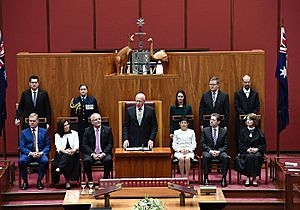
The King or Queen of Australia officially appoints the governor-general. This appointment is made based on the Australian Constitution. When a new governor-general is needed, the prime minister suggests a name to the King or Queen. By tradition, the King or Queen accepts this suggestion.
The public usually learns who the new governor-general will be several months before the current one finishes their term. After being appointed, the new governor-general takes an oath to be loyal to the King or Queen. They also take an oath to do their job well. These oaths are usually given by the Chief Justice of Australia in the Senate chamber.
How Long They Serve
The Constitution does not set a fixed time for how long a governor-general serves. However, in recent years, they usually serve for five years. Sometimes, their term might be extended for a short time. This can happen to avoid problems during an election or political difficulties.
Three governors-general have resigned from their position. The first, Lord Hopetoun, resigned in 1903. Sir John Kerr resigned in 1977. In 2003, Peter Hollingworth stepped down due to controversial allegations. In 1961, Lord Dunrossil was the first and only governor-general to die while in office.
If the governor-general resigns, dies, or cannot do their job, an "administrator" steps in. This also happens if the governor-general is travelling overseas for official duties. Usually, the longest-serving state governor takes on this temporary role.
Can a Governor-General Be Removed?
The King or Queen can remove a governor-general before their term ends. However, this can only happen if the prime minister advises it. The prime minister is responsible for choosing a replacement. During the 1975 Australian constitutional crisis, there was a situation where the prime minister and governor-general might have tried to remove each other.
What the Governor-General Does
Role in Parliament
The Australian Parliament includes the King or Queen, the Senate, and the House of Representatives. The King or Queen's role is mostly symbolic. The governor-general handles most of the King or Queen's duties related to Parliament.
These duties include calling Parliament to meet, ending parliamentary sessions, and calling for elections for the House of Representatives. The governor-general also gives royal assent to bills. This means they sign bills passed by Parliament to make them laws. This usually happens 28 days after signing, or on a date set later. The governor-general is expected to approve bills passed by the elected Parliament. They have never refused to do so.
The governor-general also has a ceremonial role. They swear in new members of Parliament. When Parliament opens, the governor-general gives a speech in the Senate. This speech is written by the government and explains their plans for new laws.
Sometimes, the governor-general can "reserve" a bill for the King or Queen's personal approval. This power was used more often in the past when Australia was more closely linked to Britain. Now, it is only used for bills that directly affect the King or Queen, or for very important national laws like the Flags Act 1953. The governor-general can also send a bill back to Parliament with suggested changes. This happens if the government realizes a bill needs more changes after it has been passed.
Role in Government Decisions
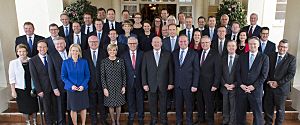
The Constitution says that the King or Queen has the power to make government decisions. However, the governor-general uses this power. They do this by acting on the advice of ministers. This advice comes from the Federal Executive Council, which includes all current ministers. The decisions are usually made first by the Cabinet, which is the main decision-making group in Australia.
Many government powers are also given to the governor-general by laws. This allows the government to act quickly without needing a new law for every situation. For example, the governor-general can declare an emergency. This happened in March 2020, when a human biosecurity emergency was declared due to the COVID-19 pandemic.
The governor-general has the right to be consulted by the government, to encourage them, and to warn them. However, they do not have regular weekly meetings with the prime minister like in some other countries.
Special Powers (Reserve Powers)
Reserve powers are special powers the governor-general can use on their own. They can use these powers without or against the advice of ministers. Most of these powers are in the Constitution. However, the exact situations when they can be used are not clearly written down. They are based on tradition.
Generally accepted reserve powers include:
- Choosing a prime minister if no party wins a clear majority in an election.
- Dismissing a prime minister who has lost the support of the House of Representatives.
- Refusing to dissolve the House of Representatives (meaning not calling an election).
Other reserve powers are more debated, such as:
- Refusing a "double-dissolution" (a special type of election).
- Dismissing a prime minister who cannot get money approved by Parliament and refuses to resign.
- Refusing to approve a bill.
The most famous use of reserve powers happened during the 1975 Australian constitutional crisis. Governor-General Sir John Kerr dismissed the government of Gough Whitlam. He then appointed Malcolm Fraser as prime minister while an election was held. This happened because the Senate blocked money for the government. This event is still highly debated in Australian history.
Community and Diplomatic Roles
Community Role
The governor-general often becomes a patron of different charities and community groups. They give out awards and host events for various people, including ambassadors from other countries. They also travel a lot within Australia. For example, Sir William Deane (governor-general 1996–2001) said one of his jobs was to be "Chief Mourner" at important funerals. This role shows that the governor-general represents the whole nation.
Sometimes, this public role can become difficult if the governor-general is not popular. For example, Sir John Kerr's public role was reduced after the 1975 crisis.
Diplomatic Role
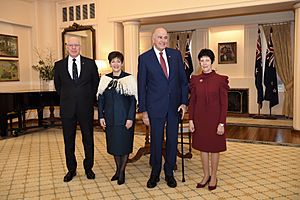
The governor-general makes official visits to other countries on behalf of Australia. When they are away, an "administrator" takes over their duties. This right for governors-general to make state visits was confirmed in 1926. However, an Australian governor-general did not make such a visit until 1971, when Paul Hasluck visited New Zealand. Since then, governors-general have travelled widely and made many state visits.
The governor-general also formally approves Australia's ambassadors by sending official letters to foreign leaders. They also receive letters from foreign countries when new ambassadors arrive in Canberra.
Military Role
According to the Constitution, the governor-general is the command-in-chief of Australia's military forces. This means they are the highest authority in the military. They appoint the head of the Defence Force and can call out the Defence Force. They also formally appoint all military officers.
In the past, the power to declare war belonged to the King or Queen, advised by the British government. However, during World War II, Australia's government advised the governor-general to declare war on some countries. Since then, no formal declarations of war have been made.
The governor-general's military powers are usually exercised on the advice of the government. However, there have been times when a governor-general has questioned military actions. For example, in 1970, Governor-General Paul Hasluck refused a request from Prime Minister John Gorton to send troops. This was because the Cabinet had not been consulted.
Community Involvement
The governor-general is often asked to be a patron of various charities and service groups. Historically, the governor-general also served as the Chief Scout of Australia. However, Bill Hayden declined this role because his personal beliefs were not compatible with the Scout Promise. He still served as the association's patron.
Relationship with the King or Queen
The governor-general is the King or Queen's representative in Australia. However, the powers they use come directly from the Australian Constitution. They are not just a delegate or agent of the King or Queen. This means the governor-general has their own independent role.
Even when the King or Queen visits Australia, the governor-general still performs their duties. The King or Queen does not take over these roles. For example, during the 1975 Australian constitutional crisis, the Queen's private secretary said that the power to appoint the prime minister was clearly the governor-general's decision. The Queen did not get involved in those decisions.
Special Benefits
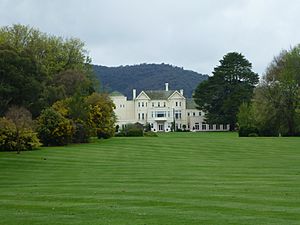
Governors-general receive certain benefits. They can live in Government House (also called Yarralumla) in Canberra, or Admiralty House, Sydney in Sydney. These are their two official homes. For travel, they have a special limousine for formal events or an armoured car for other official business. These cars display the flag of the governor-general of Australia and the Tudor Crown instead of number plates.
Salary
The governor-general's salary is set by law. It cannot be changed during their time in office. Their pay is usually a bit higher than the average salary of the Chief Justice of the High Court. Since 1995, any pension the governor-general already receives is considered when setting their salary. For example, the current governor-general, Sam Mostyn, received a larger salary increase than previous governors-general. This is because she does not receive a military pension like the previous governor-general, David Hurley.
Until 2001, governors-general did not pay income tax on their salary. This changed after Queen Elizabeth II agreed to pay tax.
Official Clothing
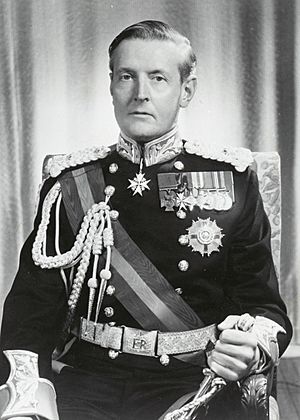
Before the 1970s, governors-general wore special traditional uniforms for formal events. These uniforms included a dark navy coat with silver embroidery, trousers, a sword, and a special hat with feathers. There was also a white uniform for warmer weather. However, this tradition stopped during the time of Sir Paul Hasluck. Now, governors-general usually wear regular clothes day-to-day.
Titles and Awards
While in office, governors-general are called His/Her Excellency the Honourable. Their spouses are also called His/Her Excellency. After leaving office, former governors-general are called the Honourable for life.
Since 1975, the governor-general has been the head of the Order of Australia. This means they automatically receive the post-nominal letters AC. In the past, they could also become a Knight or Dame in the order. However, knighthoods were removed from the Order of Australia in 2015. So, all governors-general appointed since then are Companions of the Order.
Until 1989, all governors-general were also members of the Privy Council of the United Kingdom. This gave them the title The Right Honourable for life. However, Bill Hayden, who was a republican, chose not to accept this. Since then, governors-general do not automatically receive these British titles.
The spouses of governors-general do not have official duties. However, they support the governor-general in their role. They are called Her Excellency or His Excellency during the governor-general's term.
History of the Role
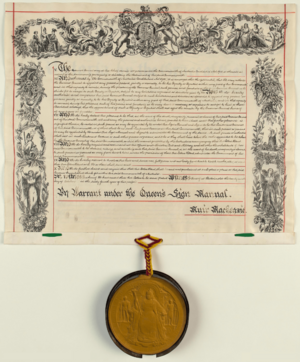
The idea of a governor-general for Australia came about during the discussions that led to Australia becoming a nation in 1901. The first governor-general was John Hope, 7th Earl of Hopetoun. He was appointed in October 1900, just before Australia became a federation on January 1, 1901. He appointed Australia's first prime minister, Edmund Barton.
In the early days, governors-general were British. They were chosen by the King or Queen on the advice of the British government. They were seen as supervising the Australian government. They could even ask the British government for an opinion before approving new Australian laws. The King or Queen could also cancel an Australian law within a year. These powers still exist in the Constitution but are not used today.
Australians Take the Lead
In 1919, Prime Minister Billy Hughes asked that Australia have a say in choosing the King's representative. He also suggested that Australians should be able to be chosen for the role. This idea was not popular with the British government at first. However, over time, Australia gained more influence.
A big change happened in the 1920s. After a meeting in 1926, it was decided that the governor-general would no longer represent the British government. Instead, they would represent only the King or Queen in Australia. This meant they were equal in status to the King or Queen in Britain.
In 1930, King George V and Australian Prime Minister James Scullin discussed who should be the next governor-general. The King wanted a British person, but Scullin insisted on an Australian, Sir Isaac Isaacs. Scullin argued that the King should follow the advice of his Australian prime minister. The King eventually agreed, but he was not happy about it.
This decision set an important example. It became a tradition that the governor-general is a citizen of the country they serve. They are also appointed on the advice of that country's government.
After this, Australia continued to appoint British people for a while. But in 1947, a second Australian, William McKell, was appointed. Since 1965, only Australians have held the position of governor-general.
Who Becomes Governor-General?
Most governors-general before 1965 were born in Britain. The exceptions were Sir Isaac Isaacs and Sir William McKell, who were Australian-born. Since 1965, all governors-general have been Australian citizens. Sir Ninian Stephen (1982–1989) was born in Britain but was an Australian citizen.
Quentin Bryce (2008–2014) was the first woman to be appointed to the office. Sir Isaac Isaacs and Sir Zelman Cowen were Jewish. Bill Hayden was an atheist during his term. Most other governors-general have been Christian.
Many governors-general had important jobs before. Some were governors of Australian states, like Lord Hopetoun (Victoria) and Quentin Bryce (Queensland). Others were leading politicians or judges, such as Lord Casey, Sir Paul Hasluck, and Sir William Deane. The current governor-general, Sam Mostyn, has a background in business and community leadership.
Timeline of Governors-General

See also
 In Spanish: Gobernador general de Australia para niños
In Spanish: Gobernador general de Australia para niños
- History of Australia
- Constitutional history of Australia
- Chapter II of the Constitution of Australia
- Governors of the Australian states
- Viceregal consort of Australia
- Armorial of the governors-general of Australia
- British Empire
- Royal Australian Air Force VIP aircraft
- Governor-general (links to other countries which have governors-general)
- Australian VIP transport
- Musical composition Earl's March written by Australian author Walter J. Turner in 1889 dedicated to Adrian Hope, while in office.


